Introduction
TREEHOPPERS provides online access to unique bibliographic and taxonomic resources for retrieving information on the insect families Aetalionidae, Melizoderidae, and Membracidae, collectively known as treehoppers. The dazzling array of treehopper body shapes and behaviors invite us to imagine, explore, question, and discover. The mission of the TREEHOPPERS website and database is to support these lofty pursuits among students, teachers, researchers, and the general public.
Overview of Treehoppers
Treehoppers make up a group of more than 3500 described species of plant-feeding insects in the order Hemiptera. Of the three treehopper families, Membracidae is by far the most diverse (428 genera and more than 3450 species), followed by Aetalionidae (6 genera, 42 species), and Melizoderidae (2 genera, 8 species). Recent phylogenetic analyses suggest treehoppers form a monophyletic lineage, as yet unnamed, related to leafhoppers, within the superfamily Membracoidea. Treehoppers are found in all major zoogeographic regions of the world. Europe has relatively few species, and Madagascar and New Zealand have no known indigenous species.
Aetalionidae
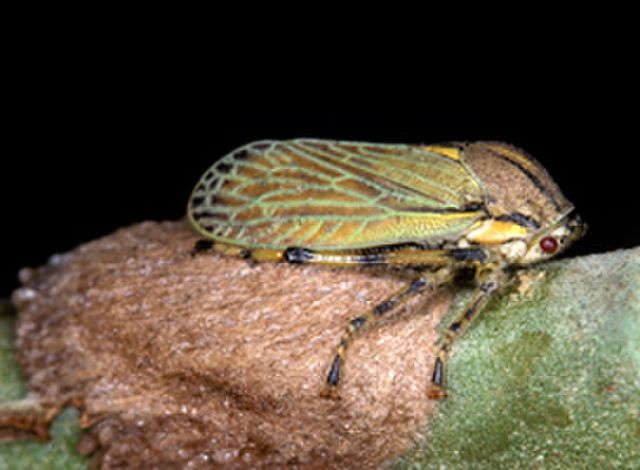
|
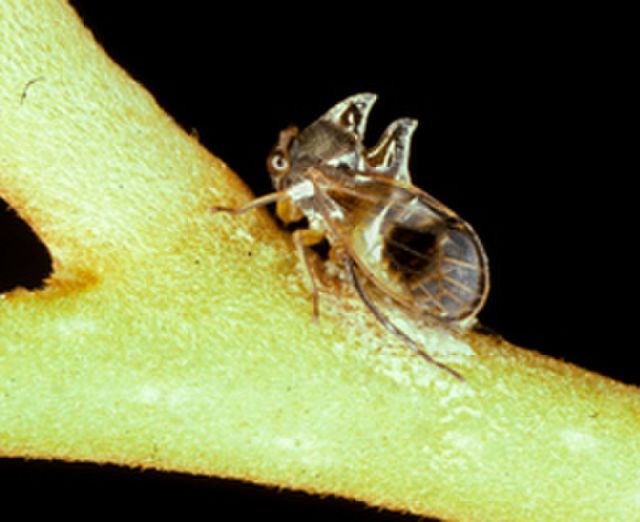
|
Melizoderidae
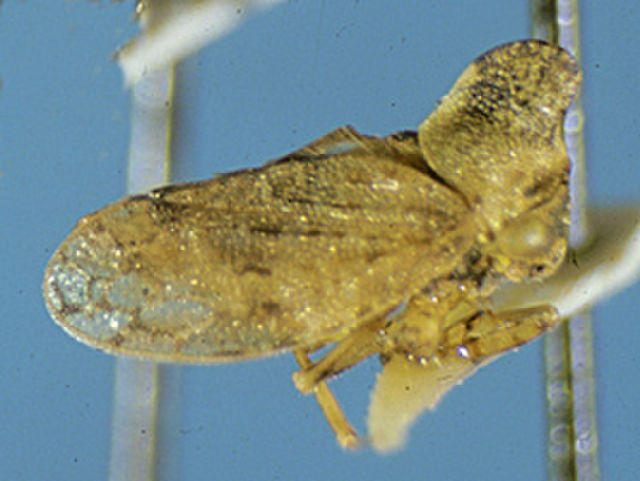
|
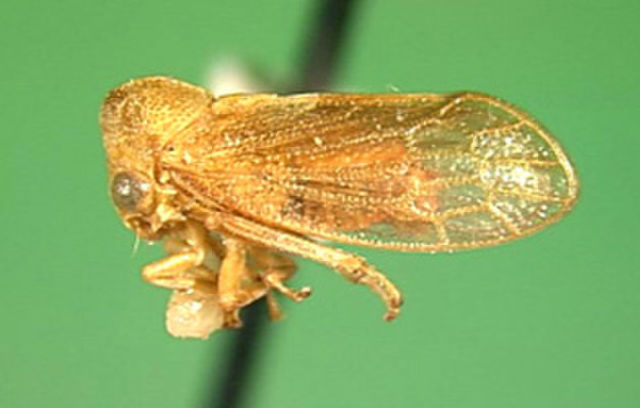
|
Membracidae
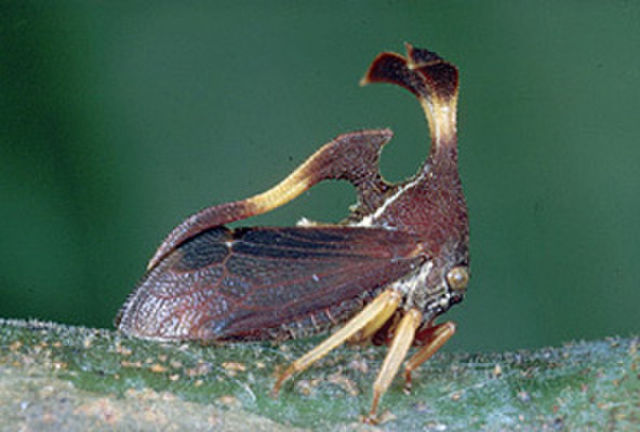
|
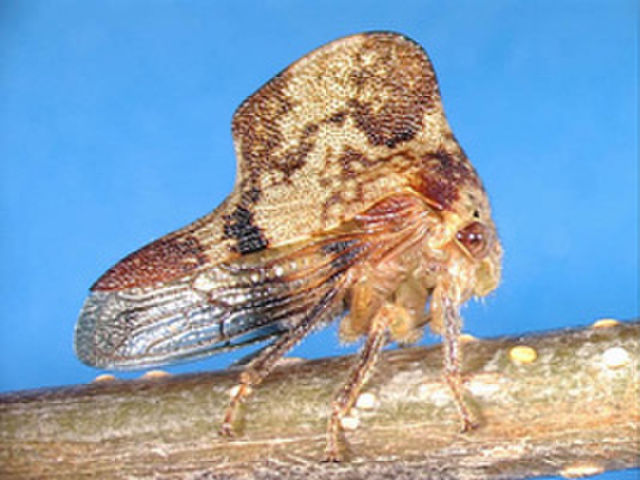
|
Morphological, Behavioral, and Ecological Diversity
| For many, but not all treehoppers, the most prominent feature is an oddly-shaped pronotum. Although once placed in a single genus, the three bizarre species illustrated here actually represent three unrelated membracid subfamilies (1, Stegaspidinae; 2, Heteronotinae; and 3, Membracinae; plate 25, Duncan 1843a, Homoptera, in Introduction to Entomology). Less obvious is the presence of three or fewer longitudinal rows of enlarged setae (cucullate) on the tibia of the hind leg. In nearly all adults of the family Membracidae (2-24 mm in length) the pronotum is noticeably enlarged and extends posteriorly over the scutellum. Also, in membracid males, distinct lateral plates are differentiated from abdominal tergum IX, and, in nymphs (many of which have dorsal spines), abdominal segment IX forms an unbroken sheath around segment X. Melizoderid adults (4-6 mm in length) have an anterior pronotal horn, but the posterior pronotal process (characteristic of most membracids) is absent, so the melizoderid scutellum is fully visible. In melizoderid nymphs abdominal tergum IX completely conceals the anal orifice dorsally. Aetalionids (3-30 mm) may have various modifications of the head (simple or with a pair of dorsal horns), pronotum (simple or with a middorsal process), or scutellum (fully visible and either simple or with an elevated keel). Also, in aetalionids the prothoracic trochanter and femur are fused, and females have abdominal tergum IX produced posteroventrally.
Treehoppers are recorded from many herbaceous and woody host plants representing more than 100 plant families. Polyphagy is widespread among tropical treehoppers, but many Nearctic species are found on a single host genus or family. Among insects, treehoppers have an unusual array of behaviors and ecological interactions. Using vibrational songs transmitted through their host plants, they are able to communicate alarm, discovery, and courtship signals. As a by-product of ingesting large quantities of plant sap (phloem), treehoppers secrete a sugary substance called "honeydew", which serves as food for a variety of opportunistic ants, bees, and wasps. Thus, treehoppers frequently benefit from interactions with ants that provide "house cleaning" services and sometimes protect the hoppers from predators in exchange for the honeydew secretions. While some species are solitary, many treehoppers are gregarious or subsocial, and may even guard their eggs and immatures. Both parental care and ant mutualism are common among aetalionids as well as membracids. Aetalionids and some membracids deposit egg masses on the surface of plants. Most membracids, however, insert the eggs into plant tissue; in so doing, a few species injure their hosts so seriously that they are considered pests. |
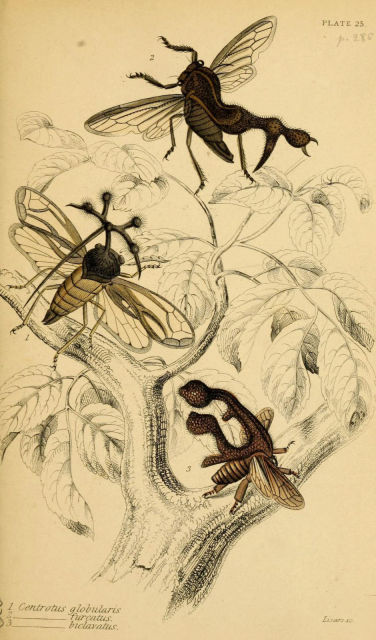
|
|||
Treehoppers as Models for Research and Discovery
The diverse morphological, behavioral, ecological, and distributional patterns among treehoppers make them an ideal group for exploring evolutionary relationships and the connections among form, function, genetics, the environment, and biogeography. The use of treehoppers as model organisms in evolutionary biology is ever increasing as evidenced by research in such areas as sympatric evolution, acoustic communication, host plant associations, biogeography, behavior, and evo-devo biology.
Recent phylogenetic studies are helping to unravel patterns in behavior and biogeography. For example, morphology-based analyses suggest that all Old World membracids (17 tribes) arose from two separate colonizations from the New World. These accidental colonizations set the stage for tantalizing “natural” experiments in evolution, running over millions of years, wherein treehopper lineages on opposite sides of the planet would radiate into parallel niches. This grand experiment, both spatially and temporally, brings to mind countless questions about key morphological and life history traits that may be addressed by comparing various attributes among Old and New World treehopper faunas.
Treehoppers are significant components of many ecosystems around the world. Distributional patterns among living treehoppers reveal hot spots of diversity that merit diligent study by those concerned with preserving global biodiversity. Within the Nearctic region, Arizona stands out as a treehopper hot spot, and on a global scale, Mexico, Brazil, the Caribbean, Australia, China, and India are likewise areas of concern with many endemic genera.
All treehoppers feed on plant sap, and the loss of host species could seriously impact treehopper diversity. Members of the membracid subfamily Centrotinae alone are reported from 105 different plant families. Nevertheless, treehoppers are so named because many species are associated with trees. Indeed, the United States has nearly 100 species associated with oaks (Quercus spp.), a dominant plant group of the native forests. Hidden in the canopy of the Neotropical forests is an even more amazing treehopper fauna, apparently rich in species that remain to be discovered. The abundance of treehoppers in the forest canopy makes them important in the diet of insectivorous animals including other arthropods and various vertebrates.
In the United States, relatively few treehoppers are considered economically important, but in the tropics, species injure a variety of crops, including legumes, avocado, cacao, coffee, grape, and papaya. Treehoppers may injure plants, not only through feeding, but also through depositing their eggs in host plant tissue. At least one species is known to transmit a plant pathogen, raising the possibility that others may eventually be implicated as vectors, especially as exotic pathogens are being introduced to the United States and elsewhere at an alarming rate.
We trust that the enlightening images, sounds, life histories, and evolutionary patterns of these curious insects will be a source of joy, inspiration, and contemplation to artists, children, and everyone with an interest in the natural world.

|
About the TREEHOPPERS Website and Database
The taxonomic and bibliographic resources of TREEHOPPERS will ultimately include: (1) taxon pages (including nomenclatural information, illustrations, male courtship calls, and geographic data); (2) illustrated taxonomic keys; (3) a distributional database (in preparation) providing geographic data for each valid genus and a checklist of genera known from each of more than 400 regions and localities; and (4) an up-to-date searchable bibliography (in preparation). Our target audience includes specialists in entomology, crop protection, and zoology. The resource should also be valuable to those in related life sciences.
TREEHOPPERS is the product of a partnership among the NCSU Insect Museum, the NCSU Libraries, East Stroudsburg University of Pennsylvania, the University of Illinois, the Illinois Natural History Survey, the Systematic Entomology Laboratory (United States Department of Agriculture) and researchers at numerous other institutions [Acknowledgments]. It builds on a related broader website "DrMetcalf: a resource on cicadas, leafhoppers, planthoppers, spittlebugs, and treehoppers".
This material is based on work supported by the National Science Foundation (Grants DEB-9815867, to L. L. Deitz, Principal Investigator; and NSF DEB-9978026 PEET Program, to C. H. Dietrich and L. L. Deitz, Principal Investigators), a 2009-2010 East Stroudsburg University of Pennsylvania President's Research Fund Grant, a 2009-2010 Pennsylvania State System of Higher Education FPDC Grant, the NCSU Agricultural Research Service, and the NCSU Libraries.
Before using this site, please read the Disclaimer and Data Use Policy below. For optimal performance, this site and others using mx software are best viewed with the browser FireFox. To view copyrights and enlarge images, click on the thumbnail images. Images may also be zoomed using [Control] and [+], [-], or [0].
Suggested citation of the electronic publication TREEHOPPERS: Deitz, L. L., and M. S. Wallace (team leaders). 2010 (and updates). Treehoppers: Aetalionidae, Melizoderidae, and Membracidae (Hemiptera). http://treehoppers.insectmuseum.org, visited on Mon Aug 22 12:45:47 -0500 2011. [note: various additional authors are listed in each section]
Introduction prepared by L. L. Deitz, M. S. Wallace, C. H. Dietrich, S. H. McKamey, and M. J. Rothschild, 14 July 2010 (revised 22 August 2011).
Contact us: ,

